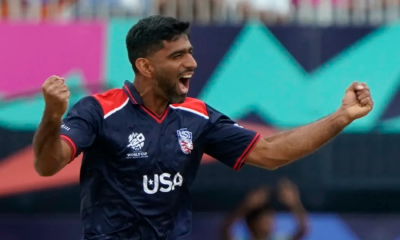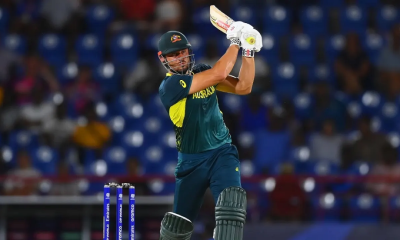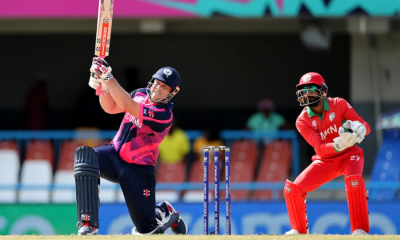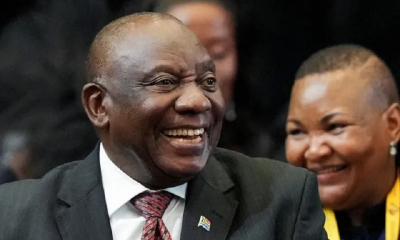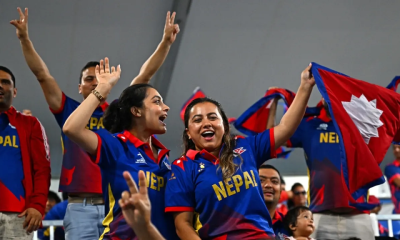Sports
Labuschagne, Warner blaze tons in Australia’s romp to 2-0 lead
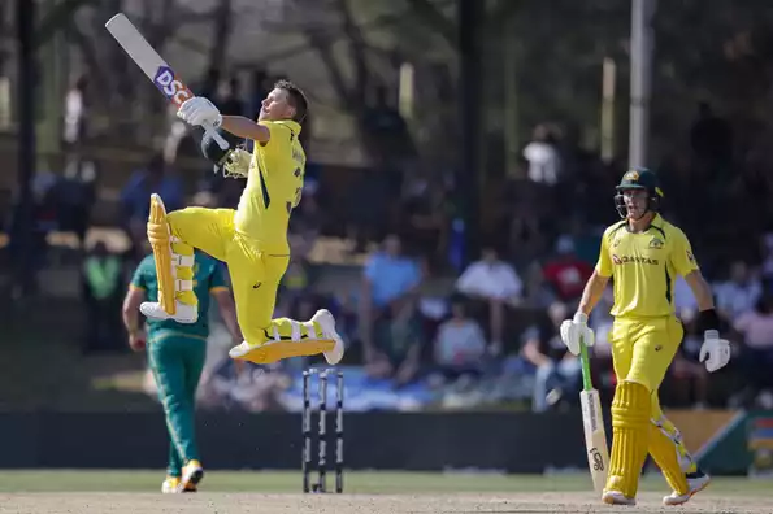
Two days can make a lot of difference. At the same Mangaung Oval that saw a 222-plays-225 contest 48 hours ago, Australia turned up the batting oomph to post a gargantuan 392 before burying their hosts under this mountain of runs to take a 2-0 series lead in the ODI series, reinforcing their credentials as one of the early favourites at next month’s World Cup. This was still a mostly experimental side from the five-time champions but they still packed enough punch to pummel their hosts to the tune of 123 runs. Leading their batting charge was Marnus Labuschagne with a second straight demonstration of why he should also be on the plane to India. He hit 124 off just 99 balls with David Warner dovetailing brilliantly with his 20th ODI ton. Adding the gloss to the performance was a four-fer from the continually impressive Adam Zampa, who took 4 for 48 from nine overs of excellent legspin bowling to douse South African hopes.
The visitors turned up on a true batting surface with an aggressive approach. This was predicated on the fact that they fielded one proper bowler less. They handed debuts to Aaron Hardie and Tim David while Nathan Ellis came on for Josh Hazlewood. Incidentally, South Africa captain Temba Bavuma made three changes — Shamsi, Anrich Nortje and Andile Phehlukwayo in for Lungi Ngidi, Gerald Coetzee and Keshav Maharaj — of his own and opted to field.
Very early it became apparent that this wasn’t going to conform to the script of the opening game. The pace and carry was true and batters could hit through the line. The first two overs of the innings saw as many five boundaries struck with Head hitting four of them, including three off Kagiso Rabada’s first over. After his lead pacer went for 20 from his first two overs, Bavuma was quick to ring in a bowling change but after giving away just three runs from his opening over, Nortje was taken apart for 17 in his second with both Head and Warner hitting a six each
After eight overs, Australia had raced off the blocks to 71/0 and the South Africa captain turned to spin for respite. None of it was forthcoming as Warner put away two short deliveries from Aiden Markram before playing a pleasing inside-out loft over extra cover to complete a 12-run initiation. In the next over, Head launched two more sixes off Nortje to race to a 26-ball half-century and give his side a PowerPlay score of 102/0 — the highest in ODIs in South Africa.
South Africa caught a break eventually in the 12th over when Head mishit a loft off Shamsi, South Africa’s best bowler of the evening, and saw David Miller complete an excellent catch running back from mid-on. The left-arm legspinner struck for a second time a ball later when Mitchell Marsh missed an attempted reverse sweep and was dismissed LBW courtesy a DRS review.
After a 109-run opening partnership, Australia had lost two in two. But that was no reason to dial down the tempo of the innings. Labuschagne joined Warner and instantly displayed the kind of nimble footwork that was on show two nights ago when he arrived to the series as a ‘Concussion Substitute’. His battle against Shamsi had a bit of an edge to it with the batter looking to pull out the sweeps and the bowler not shy of returning words. At the other end, Warner, surprisingly, took a less dramatic route to a half-century and then marked the milestone by launching Phehlukwayo for a six.
By the 27th over, this third-wicket pair had given Australia their second century stand of the innings. Warner raced away to 93 off 77 while Labuschagne had serenely motored along to a run-a-ball 49. The veteran opener completed his 20th ODI century with a four and a trademark leap in the middle of a 16-run over from Shamsi that saw Labuschagne hit a six and four of his own. The right-hander followed that up by taking Nortje for three more fours in the following over. Such was Labuschagne’s acceleration post his half-century that he was already on 85 off 67 when Warner eventually fell – bowled to a ball that kept low – for 106.
Labuschagne eventually got to his second ODI ton off just 80 balls and shared another quickfire 83-run partnership with Josh Inglis, who added to the mayhem with a 37-ball 50. South Africa did, however, come back well in the final phase of the innings, with Shamsi taking two more wickets to finish with excellent returns of 4 for 61 and put the lid somewhat on the big hits. Australia managed only 134 for 6 from the final 18 overs, but the 48 fours and 9 sixes their batters achieved meant the score was only just shy of the rather ridiculous 400-mark.
It was always going to be a steep ask from the Proteas to keep up with the scoreboard pressure. But they did make a fist of it in the early running when Quinton de Kock and Bavuma added 81 runs in 9 overs before the keeper-bat fell to a sharp return catch from Nathan Ellis for 45. The introduction of Zampa then put the brakes on the chase with the ace legspinner trapping Bavuma LBW for 46 while attempting a paddle sweep and then having Aiden Markram caught. When Rassie van der Dussen dragged a Hardie delivery on to his stumps, the game appeared to have been settled.
But Heinrich Klaasen kept South Africa in the game with a series of superb strikes, especially off the bowling of Head. Zampa returned to castle him with a skidder. David Miller kept the flame of the chase flickering for some more time but when he became the fourth South African batter to get out in the 40s, the writing was on the wall. The final rites were read in the 42nd over.
Brief scores:
Australia 392/8 in 50 overs (Marnus Labuschagne 124, David Warner 106; Tabraiz Shamsi 4-61) beat South Africa 269 in 41.5 overs (Heinrich Klaasen 49, David Miller 49; Adam Zampa 4-48) by 123 runs
(Cricbuzz)
Sports
Wolvaardt 115*, all-round Luus set up South Africa’s thumping win over Ireland
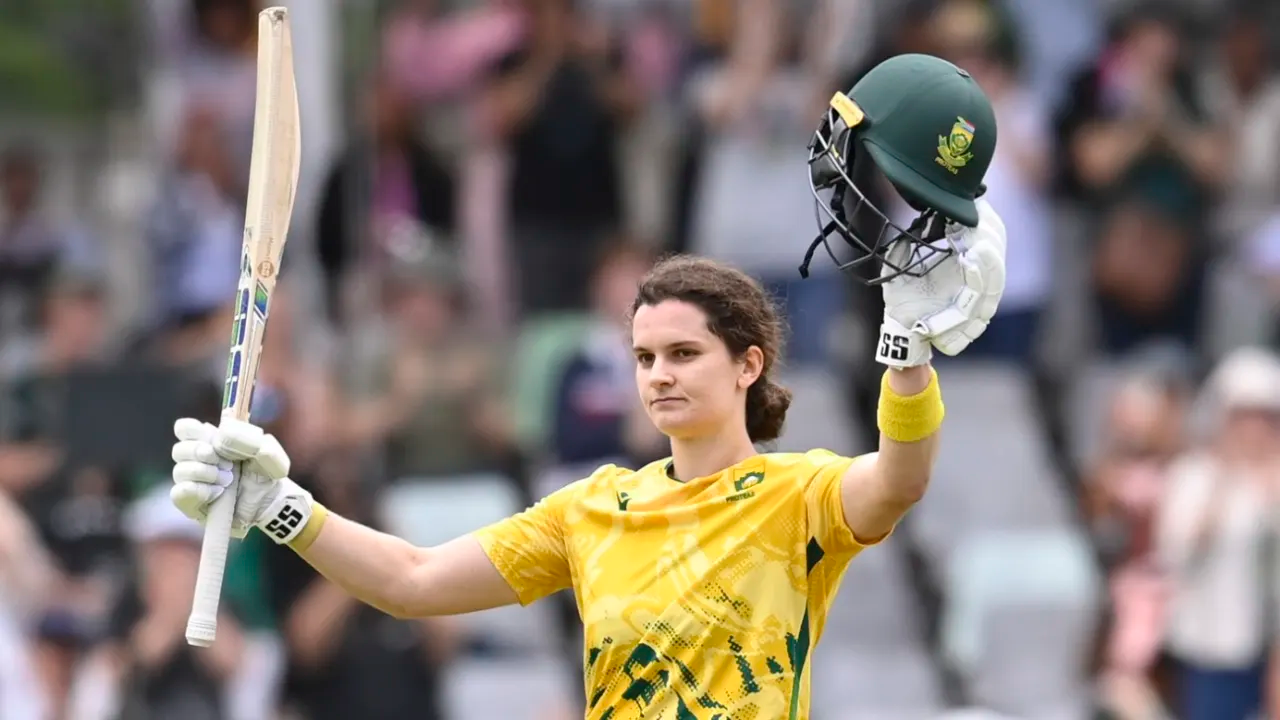
Laura Wolvaardt’s 56-ball 115 and an all-round show from Sune Luus helped South Africa beat Ireland in thefirst Women’s T20I by 105 runs, their joint third biggest win by runs, at Newlands.
Batting at No. 3, Wolvaardt scored a 52-ball century, the fastest for South Africa and the joint sixth quickest in T20Is, and was involved in a 176-run second-wicket partnership with Luus as the hosts posted their highest T20I total of 220 for 2. Having opened the batting, Luus also took the new ball and struck twice in the first over to dismiss Amy Hunter and allrounder Orla Prendergast. That effectively derailed Ireland early from what would have been an unlikely chase..
Luus and Wolvaardt got together after South Africa opted to bat and lost Faye Tunnicliffe in the second over. They started steadily before stepping on the pedal in the last two overs of the powerplay, taking 32 including a 20-run over from Lara McBride. Wolvaardt was the aggressor and she romped past fifty in just 24 balls, beating Lizelle Lee’s mark of 26 balls for the fastest T20I half century for South Africa.
Aided by plenty of misfields from Ireland, South Africa raced past 100 in the tenth over, thanks to another 20-run over, this time from Louise Little in which Wolvaardt went 6, 4, 4, 4. South Africa’s best second-wicket stand ended when Luus, on her career-best 81, tried an ungainly reverse hit against seamer Ava Canning, Ireland’s best bowler on the day, and was bowled.
That brought Dane van Niekerk, playing her first international since September 2021, to the middle. She saw Wolvaardt complete her second T20I hundred before unleashing an array of strokes to finish 21 not out of just eight balls, a strike rate of 262.50.
Only captain Gaby Lewis and Leah Paul offered a semblance of resistance for the tourists with a 42-run partnership off 39 balls. Once both of them fell in the space of 22 balls, Ireland folded quickly, losing nine wickets to spin. Luus returned as the pick of the bowlers with 4 for 22 while both left-arm spinners Nonkululeko Mlaba and Chloe Tryon took two apiece.
Brief scores:
South Africa 220 for 2 in 20 overs (Laura Wolvaardt 115*, Sune Luus 81, Dane van Niekerk 21*; Jane Maguire 1-52, Ava Canning 1-33) beat Ireland 115 in 18 overs (Leah Paul 34, Gaby Lewis 30, Laura Delany 13, Louis Little 13; Sune Luus 4-22, Nonkululeko Mlaba 2-09, Nadine de Klerk 1-13, Chloe Tryon 2-14, Nondumiso Shangase 1-13 ) by 105 runs
[Cricinfo]
Latest News
Justin Greaves 202*, Kemar Roach 58* anchor West Indies to epic draw
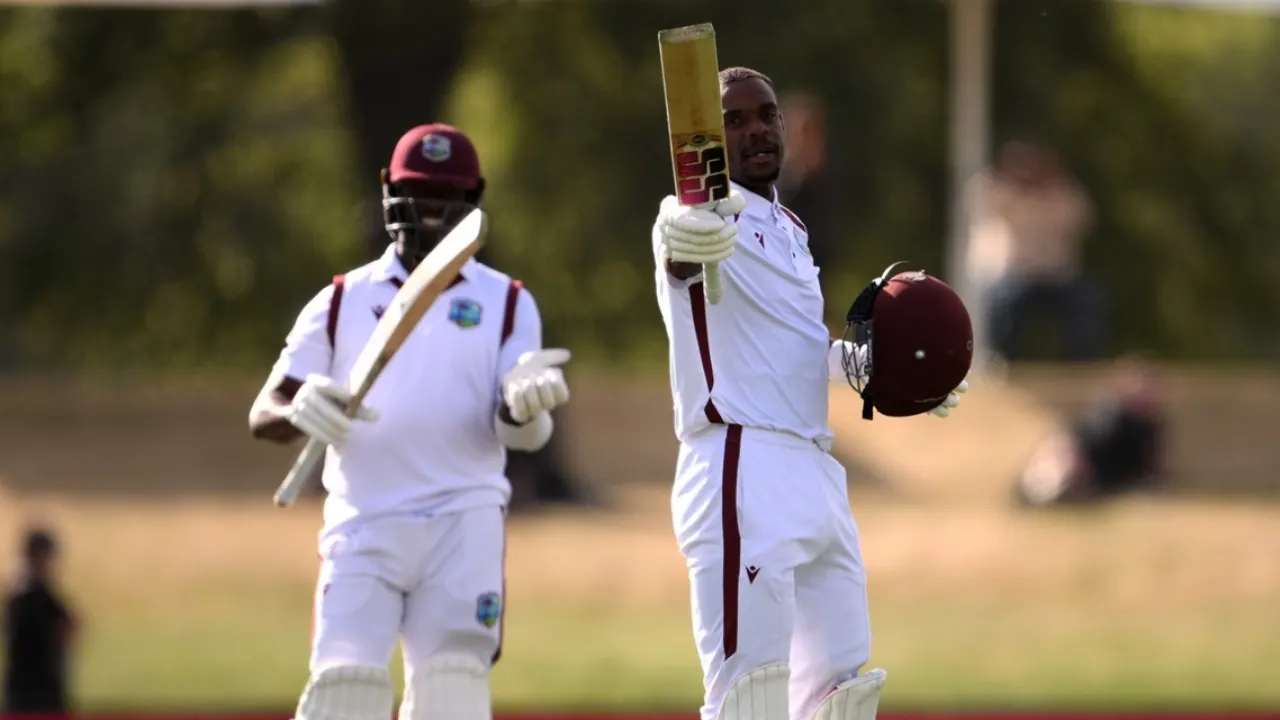
An epic stonewall from Justin Greaves had him face more than half the deliveries of his 12-Test career in this one innings alone, as West Indies pocketed their first points in their sixth Test of the 2025-27 World Test Championship cycle in Christchurch. The 163.3 overs they eventually faced is the longest fourth-innings in Tests for West Indies in 95 years.
Having played the supporting role to Shai Hope through their 196-run stand that rescued West Indies from 92 for 4 on Day 3, Greaves became the heartbeat of the innings once Hope (140) and Tevin Imlach fell in quick succession.
He brought up a stunning maiden Test double ton in the penultimate over when he sliced Jacob Duffy over backward point to pocket what was to be only his second boundary in all of the final session as his colleagues stood up to give him a standing ovation.
He finished 202 not out, having faced 388 deliveries, turning an innings that began with the typical artistic flair and flamboyance into a steely knock full of purpose and grit. Greaves wore more blows on the body than he could count, batted more deliveries than he had in his career, and reined in his natural instincts with single-minded purpose and determination.
His effort led to an astonishing turnaround from the first hour of the day, when West Indies stumbled to 277 for 6 in a mammoth chase of 531. A depleted New Zealand attack down to two weary frontline pacers in Zak Foulkes and Jacob Duffy, fancied their chances. But Greaves found an able ally in Kemar Roach, the 37-year-old veteran, who batted like his life depended on it in his comeback Test.
Roach made 58 not out – his highest first-class score – while facing 233 deliveries himself. Astonishingly, he made just 5 off the last 104 deliveries he faced during a dramatic final two hours of play even as the sun baked down hard on an increasingly docile Hagley Oval surface. Yet that should not take away from the epic rearguard from Hope, Greaves, and Roach.
The frustration of not being able to separate Greaves and Roach during the second and third sessions was evident, as New Zealand’s bowlers were ground into the dust. They would also have felt robbed when Roach appeared to have nicked Michael Bracewell to Tom Latham behind the stumps – though perhaps only having themselves to blame for burning all their reviews.
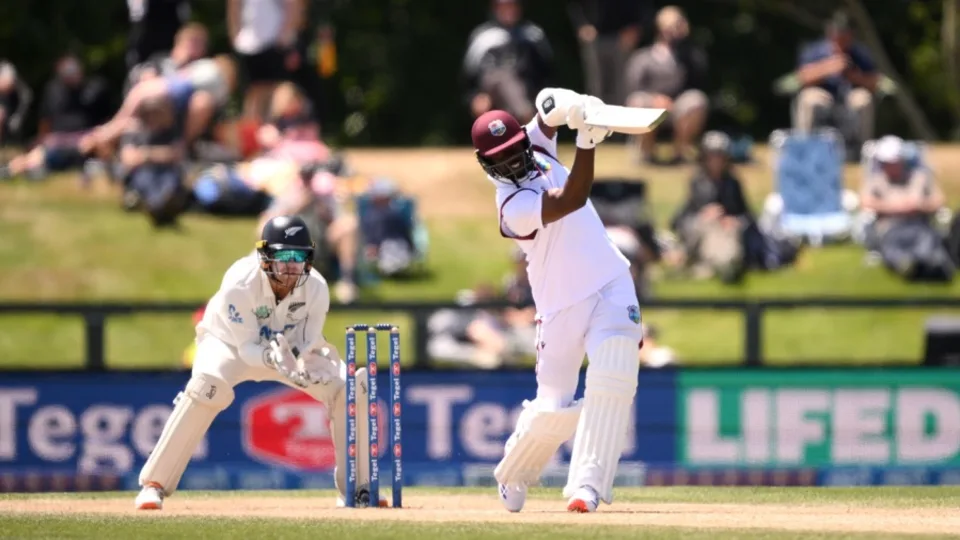
Even so, it was the thinnest of spikes that made it all the more challenging for Alex Wharf, the on-field umpire, who only a few minutes earlier made a cracking decision by turning down what everyone believed was an obvious inside-edge onto the pad to the slips, again off Bracewell. Replays showed Wharf had made a terrific call.
As admirably as Roach played, he also maximised his opportunities. On 30, he was put down by Foulkes at backward square leg when he attempted an expansive sweep off Bracewell. On 35, Blair Tickner, subbing for Matt Henry, missed a direct hit at the bowler’s end from a few yards away at short mid-on as Roach was misjudging a run.
Then on 47 came the most obvious chance, when Roach attempted to loft Bracewell had him nearly hole out to mid-on. Except, Glenn Phillips, the other sub, saw Tickner looking to intercept the ball from mid-off and palm it away.
With those three chances firmly behind him, Roach buckled down and offered a dead bat to anything that came his way against Bracewell. Foulkes and Duffy tried to ruffle him with the short ball from around the wicket, only for him to duck and weave.
Going into the final session, it became increasingly evident West Indies weren’t going to be enticed by the prospect of chasing down the 132 runs they needed in 31 possible overs. This clarity allowed them to approach the session with dead defence being the sole primary aim, even as Greaves began to tire and suffer cramps that needed medical attention at different times.
Not even the possibility of an impending double century enticed Greaves into attempting anything loose, even if Tom Latham gave him the open invitation to drive Bracewell against the turn through the covers. This wasn’t perhaps a risk not worth taking given how easily West Indies’ lower order collapsed in the first innings.
But long before a draw became the only possibility, even as New Zealand tried to attack with six fielders around the bat in the final session, Hope and Greaves pocketed runs at every available opportunity as the hosts rushed through their first six overs with part-time spin in a bid to take the second new ball quickly.
But even after they took it, there was hardly any assistance for the bowlers. Hope defended comfortably off a length with neither Foulkes nor Duffy consistently able to challenge the outside edge consistently. The occasional misfields, like – Rachin Ravindra letting one through his legs for four, or Will Young overrunning a throw while backing up – added to the sense of raggedness New Zealand had begun to feel.
A breakthrough lifted them shortly after drinks when Duffy dug in a short ball down leg, which Hope gloved behind, only for Latham to throw himself to his left and pluck a stunner from his webbing to end a marathon. Then came a second when Imlach was trapped by a nip-backer.
They may have thought then it was just a matter of time. It could’ve been had they not reprieved Roach, but those reprieves proved even more costly given they only had two fast bowlers and two part-timers available – all of them going full throttle to the limit – despite not getting much out of the surface.
In the end, the manner in which West Indies earned the draw may prove far more valuable. Above all, it was a day that reminded everyone of the slow-burn magic only Test cricket could deliver.
Brief scores:
West Indies 167 (Shai Hope 56, Tagenarine Chanderpaul 5; Matt Henry 3-43, Zak Foulkes 2-32, Jacob Duffy 5-34) and 457 for 6 (Justin Greaves 202*, Shai Hope 140, Kemar Roach 58*; Jacob Duffy 3-122) drew with New Zealand 231 (Kane Williamson 52, Michaell Bracewell 47, Jayden Seales 2-44, Kemar Roach 2-47, Ojay Shields 2-34, Justin Graves 2-35) and 466 for 8 dec (Ravindra 176, Tom Latham 145; Kemar Roach 5-78, Ojay Shields 2-74)
[Cricinfo]
Latest News
Fakhar Zaman fined 10% of match fee for showing dissent at umpire’s decision
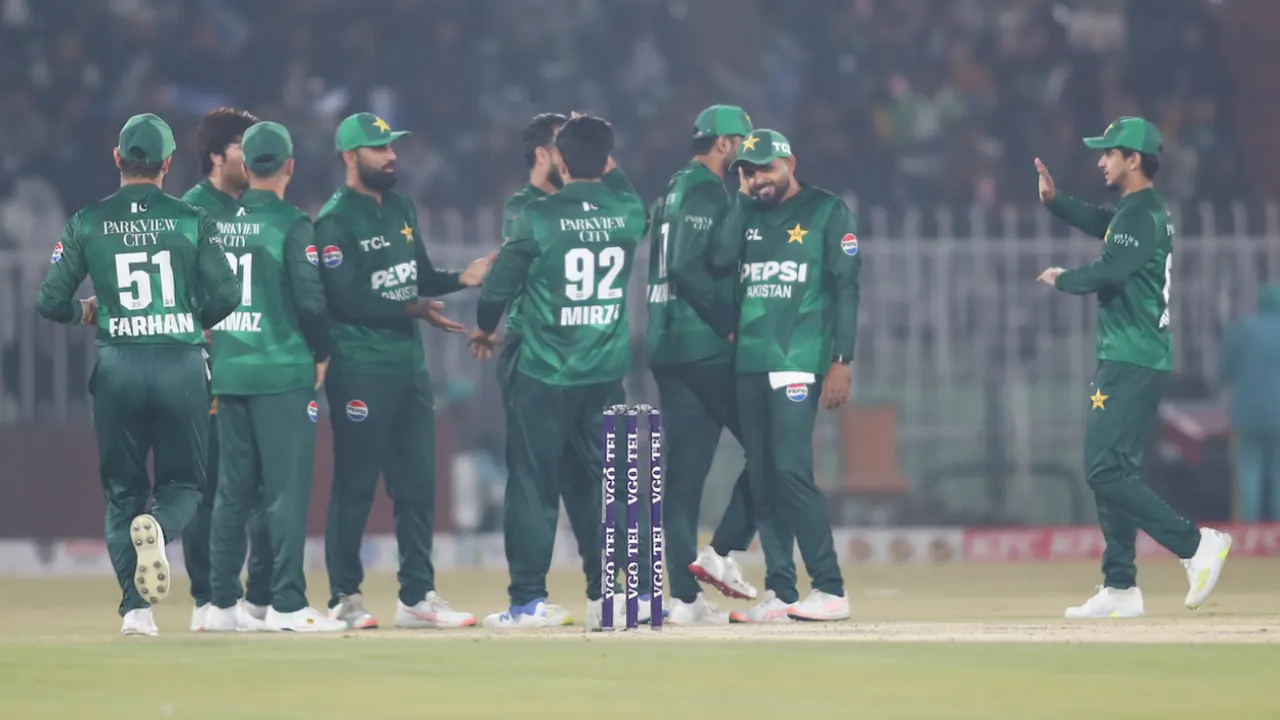
Pakistan’s Fakhar Zaman has been fined 10% of his match fee and docked one demerit point after he was found guilty of breaching level 1 of the ICC code of conduct during the tri series final against Sri Lanka on November 29.
Fakhar was found to have breached article 2.8 of the code of conduct, which relates to “showing dissent at an umpire’s decision during an international match.” He admitted to the offence and accepted the sanction proposed by the match referee, so there was no need for a formal hearing, said an ICC release.
The incident occurred in the 19th over of the final when Fakhar back-peddled from short-third, dived and seemed to have taken a stunning catch off Dasun Shanaka’s leading edge. The third umpire was called to check for the catch, and he deemed that the ball brushed the ground when Fakhar dived, and ruled it not out. Both Fakhar and the bowler, Shaheen Shah Afridi weren’t happy with the decision and made it known to the on-field umpires.
The very next ball, Shanaka swiped across the line and was clean bowled. Fakhar looked at the umpire and sarcastically appealed for the decision. Pakistan eventually won the final by six wickets as batting first, Sri Lanka collapsed in a heap, losing 9 for 30 to be bowled out for 114. Babar Azam shepherded the chase with an unbeaten 37, taking Pakistan over the line in 18.4 overs.
This was Fakhar’s first offence in a 24-month period. Level 1 breaches carry a minimum penalty of an official reprimand, a maximum penalty of 50% of a player’s match fee, and one or two demerit points.
[Cricinfo]
-

 News7 days ago
News7 days agoWeather disasters: Sri Lanka flooded by policy blunders, weak enforcement and environmental crime – Climate Expert
-
News4 days ago
Lunuwila tragedy not caused by those videoing Bell 212: SLAF
-

 News3 days ago
News3 days agoLevel III landslide early warning continue to be in force in the districts of Kandy, Kegalle, Kurunegala and Matale
-

 Latest News5 days ago
Latest News5 days agoLevel III landslide early warnings issued to the districts of Badulla, Kandy, Kegalle, Kurunegala, Matale and Nuwara-Eliya
-

 Features5 days ago
Features5 days agoDitwah: An unusual cyclone
-

 Latest News6 days ago
Latest News6 days agoUpdated Payment Instructions for Disaster Relief Contributions
-

 News24 hours ago
News24 hours agoA 6th Year Accolade: The Eternal Opulence of My Fair Lady
-

 Latest News6 days ago
Latest News6 days agoLandslide Early Warnings issued to the Districts of Badulla, Colombo, Gampaha, Kalutara, Kandy, Kegalle, Kurunegala, Matale, Moneragala, Nuwara Eliya and Ratnapura


